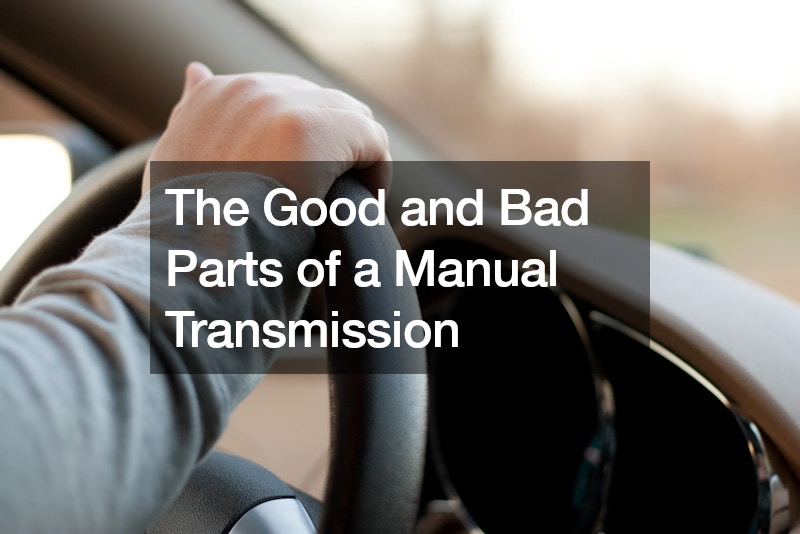
Driving enthusiasts have long cherished parts of a manual transmission for the control and engagement they offer. However, like any mechanical system, they come with their own set of advantages and disadvantages. This nuanced look into the manual transmission system will explore what makes it appealing and frustrating for drivers worldwide. Read on the following good and bad features of manual transmission.
Good: Greater Control

One of the most significant advantages of a manual transmission is the level of control it offers to the driver. By manually shifting through the gears, drivers can better manage the car’s performance and fuel efficiency, particularly in challenging driving conditions. This precise control over the vehicle’s speed and power makes understanding the parts of a manual transmission essential for any enthusiast.
The tactile experience of a manual gearbox can also enhance the overall driving experience, making you feel more connected to the car. Shifting gears on your own requires skill and attention that can make driving more engaging and enjoyable. This direct interaction with the car’s mechanics often leads drivers to choose manual over automatic despite the steep learning curve.
In the unfortunate event of a car accident, drivers with a manual transmission might have an advantage in controlling recovery. An experienced driver could downshift to regain control in certain situations. However, consulting a car accident attorney after any incident is always wise. The added layer of control offered by a manual transmission can contribute to the joy and safety of driving.
Bad: Steep Learning Curve
Learning to operate the parts of a manual transmission isn’t something you can master overnight. It requires time, patience, and frequent trips to the auto body repair shop after unintended mishaps. The coordination between the clutch, gear shift, and accelerator is intricate, demanding precision and multitasking that can be overwhelming for beginners.
For many new drivers, the initial experience with a manual car can be frustrating, filled with jerky stops and starts, especially in stop-and-go traffic or on steep inclines. This steep learning curve can deter potential enthusiasts, leading them to opt for automatic vehicles instead. It’s not just about mastering the mechanics; it’s about building the confidence to drive smoothly under various conditions.
Despite these challenges, overcoming the learning curve of a manual transmission is often seen as a rite of passage among car enthusiasts. Once acquired, it’s a skill that brings a sense of achievement and a deeper understanding of how cars operate. Yet, it’s important to remember that it’s okay to seek professional guidance or visit an auto repair shop to ensure your learning process does not lead to costly mistakes.
Good: Greater Fuel Efficiency
One of the most celebrated advantages of mastering the parts of a manual transmission is the potential boost in fuel efficiency. This is because drivers have more control over the engine’s RPMs, allowing them to optimize the power and fuel ratio better than the pre-set programming of an automatic transmission. It’s a perk that benefits your wallet and the environment by reducing fuel consumption.
Furthermore, drivers adept at using a manual transmission can often extend the longevity of their car’s engine. The ability to control the gearing allows for lower engine strain during driving, which can contribute significantly to a vehicle’s operational lifespan. This control translates into fewer visits to the repair shop. It can potentially lower general auto insurance premiums by maintaining a healthy engine.
While automatic transmissions are catching up in fuel efficiency, manuals still offer that tactile edge that can lead to savings over time. This skill set rewards not just with the satisfaction of nailing a perfect gear shift but also with tangible benefits that impact both the environment and your finances. The initial effort to learn and understand the intricacies of a manual vehicle pays off, making it a worthy consideration for anyone in the market for a new car.
Bad: Reduced Resale Value

One of the less appealing aspects of choosing a vehicle with a manual transmission is the potential reduction in resale value. Unfortunately, the demand for cars with manual transmissions has been declining steadily in the U.S., as consumers tend to favor the convenience of automatics. This trend means that when it’s time to sell, you might find it challenging to attract buyers willing to deal with the parts of a manual transmission.
Moreover, specific maintenance issues unique to manual vehicles, such as clutch replacement or gearbox repairs, can add to the overall cost of ownership. While enthusiasts might not mind the extra effort, the average buyer is likely to be deterred by the prospect of additional maintenance. Even something seemingly unrelated, like windshield replacement, could be perceived as a hassle if the buyer considers the manual transmission a drawback.
In the end, while owning a manual car offers unique advantages and joys, it’s crucial to acknowledge the potential downsides. The reduced pool of potential buyers can significantly impact how quickly and at what price you can sell your car. Remember that a manual transmission may not appeal to everyone.
Good: Better for Towing
When considering the benefits of a manual transmission, it’s essential to highlight its superiority in towing capabilities. The parts of a manual transmission allow for better control over the vehicle’s power output, making it a preferable option for heavy-duty tasks. This increased control ensures that you can adjust the power delivery to the wheels, reducing the strain on the engine during towing.
Additionally, vehicles with manual transmissions tend to offer better fuel efficiency when towing. The driver can choose the most appropriate gear for the situation, optimizing fuel consumption. Whether hauling a trailer or providing towing services, a manual car handles the job more economically than its automatic counterparts.
The durability of a manual transmission contributes to its towing prowess. These vehicles can handle the additional stress of towing without significant wear and tear, unlike some automatic transmissions that may overheat or fail under similar conditions. This makes manual transmission vehicles dependable for anyone who frequently requires these services.
Bad: Limited Availability
Finding a vehicle with a manual transmission has become increasingly challenging in recent years. Manufacturers lean towards automatic transmissions, citing higher demand and advanced technology surpassing manual systems’ efficiency. This shift has made manual transmission parts rare, making it difficult for enthusiasts to find their preferred drive system.
This scarcity isn’t just about the transmission itself. Still, it extends to the whole vehicle, including features like the truck bed in pickups. Trucks with manual transmissions used to be commonplace, offering a blend of control and utility that many drivers preferred. Now, those looking for that combination have fewer options on the market, which can be particularly frustrating for those who value manual control in a utility vehicle.
In addition, the limited availability of manual transmissions can also impact the resale market. Since fewer new vehicles are being made with these parts, finding replacements or servicing a manual transmission can become more complicated and expensive. This can decrease the vehicle’s overall value, making it less appealing for future buyers concerned about repair and maintenance challenges.
Good: Simple Components

One notable advantage of manual transmissions is the simplicity of their components. The basic parts of a manual transmission are less complex and more robust, making them less prone to failure under normal driving conditions. This simplicity also means that when something needs fixing, it’s often less complicated and, consequently, less expensive than its automatic counterparts.
Moreover, the straightforward nature of a manual transmission contributes to a more engaging driving experience. Drivers must be more involved in the process, from shifting gears to managing the clutch, which many car enthusiasts find more satisfying. It’s not just about getting from point A to B; it’s about enjoying the journey and the things to do while driving. More importantly, manual transmissions’ durability and reduced need for maintenance can significantly extend the vehicle’s lifespan. Their less complex components endure less wear and tear over time, making them a reliable and cost-effective choice in the long run, as owners spend less on repairs and replacements.
Bad: Difficulty Up Steep Hills
Driving a vehicle with a manual transmission up steep hills can present unique challenges, especially for those not well-versed in handling the clutch and gears. The requirement to balance clutch engagement with the right amount of power can be daunting, leading to a higher risk of stalling the vehicle. This situation is further complicated by the need to prevent the car from rolling backward, adding stress to drivers and putting excessive wear on the parts of a manual transmission.
Further, navigating steep inclines often requires frequent gear changes to maintain optimal power and control over the vehicle. This constant shifting can tax the driver, especially in heavy traffic or during long drives. This scenario could make one long for the simplicity of an automatic transmission or the comfort of a daycare parking lot, with its promise of a flat, easy-to-navigate surface after a challenging drive.
Driving a manual transmission car in cities with hilly terrain can ultimately affect the vehicle’s resale value. Prospective buyers, aware of the potential difficulties and increased manual transmission maintenance, might prefer vehicles that are easier to handle on steep grades. This preference can make a manual car less desirable, even if it has other appealing qualities. It underscores the importance of considering your typical driving environment before choosing between manual and automatic.
Good: Theft Deterrence
Although manual transmissions can be a challenge on steep hills, they have a unique advantage in theft deterrence. Most car thieves prefer the simplicity of an automatic transmission, making cars with manual gearboxes less appealing targets. Additionally, the intricate knowledge required to operate the parts of a manual transmission effectively acts as an additional layer of security.
This aspect can be particularly reassuring for vehicle owners in urban areas, where car theft is more prevalent. The assumption that a potential thief may pass over a manual vehicle due to its complexity of operation is a subtle but effective theft deterrent. Even a criminal attorney has noted that manual vehicles are less likely to be involved in theft cases, attributing this to potential thieves’ lack of familiarity with manual transmissions.
Maintaining the safety and security of one’s vehicle is a top priority for most car owners, and manual transmissions can contribute to that goal. Besides offering a more engaging driving experience, they also provide an unexpected benefit, reducing the likelihood of theft. Ultimately, when considering a manual transmission, its role in theft deterrence shouldn’t be overlooked, offering a silver lining to the challenges it might present.
Bad: Driver Fatigue

One significant drawback of manual transmissions is the increased driver fatigue, especially in heavy traffic situations. Continuously engaging and disengaging the clutch requires more physical effort and attention, leading to quicker exhaustion. The parts of a manual transmission demand more from the driver, making long commutes or stop-and-go traffic less bearable.
In cities known for notorious traffic jams, the constant need to shift gears can turn a thrilling drive into a tedious chore. This fatigue diminishes the joy of driving and impacts driver alertness, potentially increasing the risk of accidents. It’s a factor that car accident law firms often note when analyzing the causes behind some vehicular incidents.
The heightened effort and concentration required can lead to quicker burnout, negatively affecting one’s overall driving experience. For individuals who prioritize convenience and comfort, this aspect might steer them toward choosing an automatic transmission over a manual. Understanding this trade-off is crucial for prospective car buyers, emphasizing the need to weigh the engaging experience of a manual against the potential for increased fatigue.
The manual transmission offers advantages and disadvantages that cater to driving enthusiasts’ diverse needs and preferences. While it provides greater control, enhances fuel efficiency, and offers theft deterrence, it has a steep learning curve and reduced resale value. It can contribute to driver fatigue, especially in heavy traffic or steep inclines. Understanding the nuances of the manual transmission system is crucial for making an informed decision when purchasing a vehicle, ensuring that your driving experience aligns with your priorities and driving conditions. Whether you prioritize engagement, efficiency, or convenience, weighing the pros and cons of manual transmission against your individual needs is essential for a satisfying driving experience.



